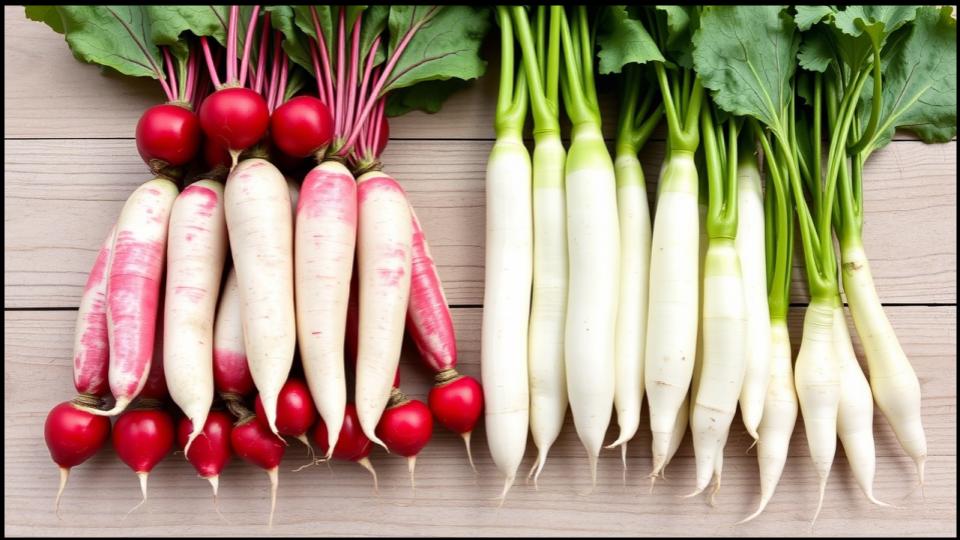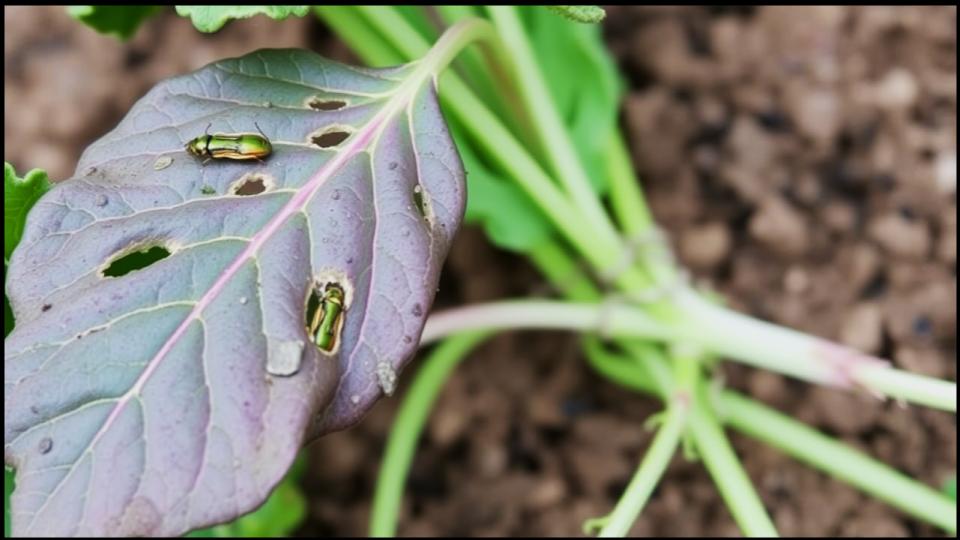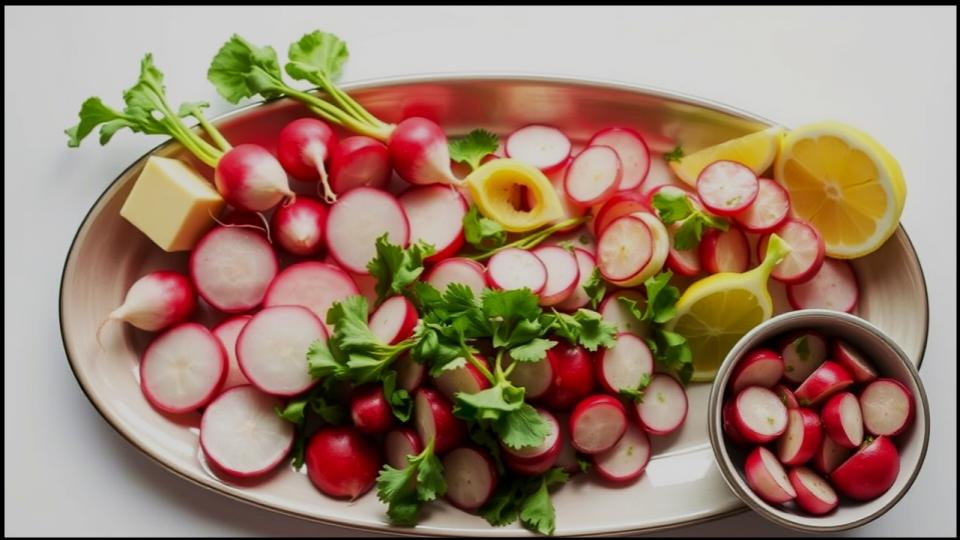
The humble radish, with its cheerful color and satisfying crunch, is a true delight in the home garden. Often one of the first rewards of spring and a welcome encore in the fall, growing radishes is a remarkably simple pleasure that yields surprisingly sophisticated results. These crisp roots can elevate a simple salad, add a peppery bite to a sandwich, or even take center stage when roasted to sweet perfection. This guide will walk you through everything you need to know to cultivate these gems, transforming your garden patch into a source of seasonal pride and deliciousness. Prepare to discover the joy of pulling your own perfect radishes from the cool earth.
Quick Tips for Radiant Radishes:
- Cool is Key: Plant radishes in the cooler temperatures of early spring or late summer/early fall for the best flavor and texture.
- Speedy Sprouts: Radishes are famously fast; many varieties are ready to harvest in just 3-5 weeks.
- Consistent Moisture: Even watering prevents splitting and woody texture.
- Loose Soil: Friable, well-drained soil allows roots to expand easily.
- Succession Sow: For a continuous harvest, plant small batches every 1-2 weeks during the ideal planting windows.
Why Radishes Deserve a Spot in Your Garden
Beyond their zesty flavor, radishes are a gardener’s friend for several reasons. Their rapid growth cycle makes them incredibly rewarding, especially for new gardeners or those gardening with children. You get to see results, and fast! In my own garden, I often use radishes as “row markers” for slower-germinating crops like carrots or parsnips; the radishes sprout quickly, defining the row, and are harvested long before the other vegetables need the space.
Furthermore, their compact size means they don’t require a vast expanse. They’re perfect for tucking into small gaps, container gardening, or raised beds. From a culinary standpoint, the spectrum of flavors – from mildly peppery to intensely spicy – and textures, from delicate to robust, means there’s a radish for every palate and plate.
Understanding the Radish: A Tale of Two Seasons
Success in growing radishes hinges on understanding their preference for cool weather. Hot temperatures can cause them to “bolt” (send up a flower stalk), which often results in woody, unpalatable roots. This is why spring and fall are the prime radish-growing seasons.
- Spring Radishes: These are typically small, quick-maturing varieties often enjoyed raw. They thrive in the gentle warmth of spring but must be harvested before the summer heat sets in. According to the University of Minnesota, planting spring radishes as soon as the soil can be worked is key.
- Fall/Winter Radishes: These varieties, such as Daikon or Spanish Black, are generally larger, can be stored for longer periods, and often develop a richer, more complex flavor in the cool autumn soil. Some even become milder and sweeter after a light frost. They are planted in late summer or early fall, maturing as temperatures drop.

Choosing Your Champions: The Best Radish Varieties for Growing Radishes
The world of radishes extends far beyond the common red globe. Exploring different varieties is part of the fun!
Delightful Spring Radish Varieties
For that quick, crisp satisfaction in spring, look for varieties that mature in 20-30 days.
- Raphanus sativus ‘Cherry Belle’: A classic round, red radish, reliably crisp and mildly spicy. It’s a favorite in my garden for its quick maturity and dependable performance.
- R. sativus ‘French Breakfast’: Oblong with a rosy-red top and a white tip, these are beautifully tender and have a lovely, mild peppery flavor. Perfect for slicing onto buttered bread, as the French do.
- R. sativus ‘Easter Egg’: Not a single variety, but a mix that produces radishes in shades of red, pink, purple, and white. They bring a wonderful splash of color to the garden and the table.
- R. sativus ‘Icicle’ (or ‘White Icicle’): These are longer, white roots, about 4-6 inches, with a crisp texture and a flavor that can range from mild to quite pungent depending on growing conditions.
Hearty Fall & Winter Radishes
These are sown in late summer for an autumn or early winter harvest. They generally take longer to mature (50-70 days).
- R. sativus var. longipinnatus ‘Daikon’: These large, white Japanese radishes can grow quite long and are prized for their crisp texture and relatively mild, sweet flavor. They are fantastic raw, pickled, or cooked. The Penn State notes their versatility in culinary uses.
- R. sativus ‘Spanish Black’ (‘Black Spanish’): With a striking black skin and crisp white flesh, this round radish has a robust, pungent flavor that mellows when cooked. It’s an excellent storage radish.
- R. sativus ‘Watermelon’ (‘Red Meat’): This fascinating radish has a greenish-white exterior but reveals a vibrant pink to magenta interior. It’s crisp, mildly sweet, and visually stunning. I love slicing these thinly for salads where their color can truly shine.
The Art of Planting: Your Step-by-Step Guide to Growing Radishes
Radishes are not fussy, but a little attention to detail at planting time will pay dividends.
Perfecting the Patch: Soil Preparation
Radishes thrive in loose, well-drained soil with a pH between 6.0 and 7.0.
- Location: Choose a spot that receives at least 6 hours of full sun per day. For fall crops, partial shade can be tolerated, especially in warmer climates.
- Soil Texture: Heavy clay soil can impede root development, leading to small or misshapen radishes. Amend clay soil with plenty of organic matter like compost or well-rotted manure to improve its structure and drainage. Sandy soil, while good for drainage, may need compost to help retain moisture. I always aim for a soil texture that crumbles easily in my hand.
- Enrichment: Work a few inches of mature compost into the top 6-8 inches of soil before planting. Avoid fresh manure or overly rich fertilizers, as this can lead to lush foliage with poor root development. Radishes are not heavy feeders.
Sowing for Success: Planting Techniques
- Timing is Everything:
- Spring: Sow seeds directly into the garden as soon as the soil can be worked – typically 4-6 weeks before the last expected frost. Continue sowing small batches every 7-10 days until late spring, before the weather turns consistently hot.
- Fall: For fall radish planting, sow seeds in late summer or early fall, about 4-8 weeks before the first anticipated fall frost. The soil is still warm, which aids germination, and the plants will mature in the cool, bright days of autumn.
- Sowing Depth: Plant seeds about 1/2 inch deep. Planting too deeply can hinder germination.
- Method: You can sow seeds in rows or broadcast them over a prepared bed. I prefer sowing in rows, as it makes thinning and weeding a bit easier. If sowing in rows, space them about 8-12 inches apart to allow for easy access.
Spacing: Giving Your Radishes Room to Grow
Proper spacing is crucial for well-formed roots. If crowded, radishes will compete for nutrients and light, resulting in small or underdeveloped roots.
- Aim to have plants spaced about 1-2 inches apart for smaller spring varieties.
- Larger fall or winter varieties will need more room, typically 3-6 inches between plants. You will thin seedlings to this final spacing once they are an inch or two tall.
Nurturing Your Crop: Essential Radish Care Tips
Once your radish seeds have sprouted, consistent care will ensure a delicious harvest.
Watering Wisely
Radishes need consistent moisture for rapid, even growth.
- Frequency: Water deeply whenever the top inch of soil feels dry. This might be daily in warmer, drier weather or every few days during cooler periods.
- Importance: Inconsistent watering can lead to a host of problems. Dry soil can make radishes woody and overly pungent, while a sudden deluge after a dry spell can cause them to split. In my experience, a soaker hose or drip irrigation is a fantastic way to provide steady moisture without wetting the foliage excessively.
The Thinning Tango
This is perhaps the most important step for successful root development.
- When: Once seedlings are about 1-2 inches tall and have developed their first true leaves, it’s time to thin.
- How: Gently pull out the weaker or overcrowded seedlings, leaving the strongest ones at the recommended spacing (1-2 inches for small types, 3-6 inches for larger types). Don’t be afraid to be ruthless here; it’s for the greater good of your crop! The thinned seedlings (radish microgreens) are edible and delicious in salads.
Keeping Weeds at Bay
Weeds compete with radishes for water, nutrients, and light.
- Mulch: A light layer of organic mulch, such as straw or shredded leaves, can help suppress weeds and retain soil moisture. Apply it once the radishes are a few inches tall.
- Gentle Cultivation: If you do need to weed by hand or with a hoe, do so carefully to avoid disturbing the shallow roots of the radish plants.
Sunlight Savvy
While radishes need sun to thrive, intense summer sun can be detrimental, especially to spring crops.
- Spring Crop: Full sun (6+ hours) is ideal.
- Fall Crop: Full sun is still good, but if you’re planting in late summer when it’s still quite hot, a location that gets some afternoon shade can be beneficial.
Troubleshooting Common Radish Woes
Even the most attentive gardener can encounter issues. Here’s how to handle them:
- Pesky Pests:
- Flea Beetles: These tiny black beetles chew small “shot holes” in radish leaves. While minor damage won’t usually affect the roots, severe infestations can weaken plants. Floating row covers, installed at planting, are the best organic defense. I’ve found that quick maturity of spring radishes often means they are harvested before flea beetles become a major issue.
- Root Maggots: These larvae tunnel into radish roots, making them inedible. Crop rotation is key; avoid planting radishes or other brassicas (cabbage family) in the same spot year after year. Protective row covers can also prevent the adult flies from laying eggs. The University of Wisconsin-Madison Division of Extension Horticulture provides good insights on managing these pests.
- Common Diseases: Radishes are relatively disease-resistant, especially if grown quickly in good conditions. Fungal diseases like downy mildew can occur in overly damp, crowded conditions. Ensure good air circulation and avoid overhead watering if possible.
- Bolting & Woodiness:
- Bolting: This occurs when the plant sends up a flower stalk, usually triggered by hot weather or inconsistent watering. The root will become tough and pungent. Plant at the right time and harvest promptly.
- Woodiness: Caused by leaving radishes in the ground too long, inconsistent watering, or hot weather. Harvest spring radishes as soon as they reach a usable size.

Harvesting Your Rewards: When and How to Pick
The best part! Knowing when to harvest is key to enjoying radishes at their peak.
- Spring Radishes: Check for maturity based on the days-to-harvest indicated on your seed packet (usually 20-35 days). Gently push aside the soil at the base of the leaves to check root size. They are best when about 1 inch in diameter. Don’t let them get too large, or they can become woody or pithy. I like to pull one or two as “testers” once they approach maturity.
- Fall/Winter Radishes: These can stay in the ground longer, often improving in flavor after a light frost. Harvest before the ground freezes solid.
- Technique: Grasp the leaves firmly at the base and pull gently. If the soil is compacted, you might need to loosen it with a trowel first. Brush off excess soil.
Beyond the Salad Bowl: Enjoying Your Radish Harvest
While fabulous raw, don’t limit your radishes to salads!
- Roasted: Roasting radishes mellows their spice and brings out a surprising sweetness. Toss with olive oil, salt, and pepper, then roast at 400°F (200°C) until tender-crisp.
- Sautéed: Quickly sauté sliced radishes with butter and herbs for a delightful side dish. Radish greens can also be sautéed like spinach!
- Pickled: Quick-pickled radishes are a zesty addition to tacos, sandwiches, and grain bowls.
- With Butter and Salt: A classic French way to enjoy spring radishes – simply serve fresh, crisp radishes with good quality unsalted butter and flaky sea salt. It’s an experience!

Fall Radish Planting: A Second Chance for Radish Bliss
Don’t let the end of summer mean the end of your radish harvest. Fall radish planting is a fantastic way to extend your season. The cooling temperatures and still-warm soil create perfect conditions for many varieties, especially the larger storage types.
- Timing: Sow seeds in late summer (August to early September in many regions) to allow them to mature before hard freezes. Check your local first frost date and count back the days to maturity for your chosen variety.
- Benefits: Often, fall-grown radishes experience fewer pest problems as insect populations decline. The flavor can also be superior, as the cool weather encourages sugar development. For me, a fall radish crop is a promise of crisp, peppery goodness well into the cooler months.
TOOLS AND MATERIALS BOX
- Radish Seeds: (Choose spring or fall varieties)
- Garden Trowel or Hand Fork: For loosening soil.
- Compost or Well-Rotted Manure: For soil enrichment.
- Watering Can or Hose with a Gentle Spray Nozzle: For consistent watering.
- Row Cover (Optional): For pest protection.
- Garden Marker/Label: To remember what and when you planted.
- Measuring Stick/Ruler: For spacing seeds and rows.
Conclusion
Growing radishes is a wonderfully straightforward endeavor that brings swift and satisfying rewards to any home gardener. With a little understanding of their needs – cool weather, consistent moisture, and well-prepared soil – you can enjoy a continuous supply of these peppery delights from early spring through the crisp days of fall. Whether you’re after the quick crunch of a ‘Cherry Belle’ or the robust character of a ‘Spanish Black’, the simple act of sowing these seeds connects you to the rhythm of the seasons.
So, make space in your garden for radishes. Experiment with different varieties, savor their fresh flavor, and enjoy the simple, elegant pleasure of a truly homegrown harvest. Happy planting!
Read More
8 Delicious Fruits You Can Grow in Pots—Even on a Tiny Balcony
